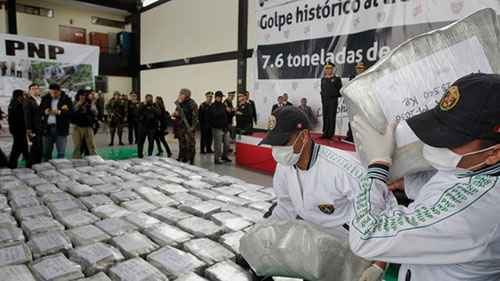It’s not important in the context of “stopping the drug trade” — that’s not actually going to happen — but it is important in terms of this:
“In Peru we don’t have drug cartels, we have collectors linked to a foreign cartel or organization. We assume, because it is still under investigation, that Mexican cartels have come to establish two legal export companies and once they are seen as serious companies in the market they are used to take the drugs out of the country,” Urresti said.
My wife is Peruvian — hence my in-laws are — so this stuff has periodically interested me. I’ve written about El Chapo twice — here and here — and one time, back in Minneapolis, I was scrolling through a bunch of articles on my phone while my wife did a job interview. I found out this whole thing about how Sinaloa — the main Mexican cartel, and the one associated with El Chapo — deals with Peru.
See, Peru produces the most cocaine in the world, but the Mexicans tend to organize all the logistics and infrastructure around the transport of drugs. (I could be wrong about a lot of this, admittedly, but I don’t think I am.) I’ve seen articles that Peruvians involved in the process will get about $2 for every $20 a Mexican higher up the chain gets. (Again, since illegal drug industry numbers aren’t reported in any type of printout, I’m not sure anyone knows the exactitude of it.)
This seven-ton bust was hidden in blocks of coal — previously drugs have been hidden in banana shipments, among countless other things — and was destined for Belgium and Spain. The street value was $300 million.
Now, Belgium and Spain will have access to cocaine tomorrow — at least, the people who want said access will have it — so that’s not really the issue. The illegal drug trade is essentially unstoppable so long as the demand is there and people are willing to work within it. (Both of those things are likely to remain true.)
The interesting thing about this Peru dynamic is that now, the whole thing seems a bit more de-centralized. Most of the cocaine is grown in Peru, but the logistics are organized by Mexico — and the product needs to get to Europe, Asia, et al.
The more de-centralized the process becomes, you could theoretically see more of these larger-sized busts over time — because when more people have to coordinate to make something happen, there’s a higher probability that someone along the chain will EFF something up. I mean, that’s only logical, right?
This cocaine seized had a lion symbol on it, which is believed tied to Mexicans. For example:
“Gulf Cartel or Cartel del Golfo associates used the MGM lion a couple years ago, as well as the initials ‘CDG,’” the bulletin stated, adding, “it appears that they are now using the ‘John Deere logo.’”
The ranch’s owner was Jesus “The King” Zambada, a leader of the powerful Sinaloa drug cartel. He had developed a love for exotic species shared with other kingpins. Just two days before Zambada’s arrest, police confiscated two tigers and two lions from a drug gang hideout on the forested outskirts of Mexico City.
Remember — drugs are all about branding, at some level. Lions are cool, king-of-the-jungle animals that, apparently, Mexican drug lords like to collect. So there’s a tie.
But interestingly on all this, de-centralization in a legitimate business tends to lead to more creativity; in a business that needs to hide itself and coordinate among dozens (if not hundreds) of people, de-centralization among nations could lead to a lot more massive product seizures.
